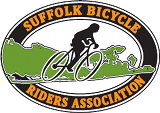- Rides
- Ride Statistics
- Join/Renew SBRA Now
- NEW to SBRA?
- Forums
- Recent Posts -See what's NEW
- Rolling Wheels Newsletters
- Bike Shop Program
- Other Rides & Events Calendar
- About SBRA
- Contact SBRA
- General Information
- Be a Ride Leaders
- Ride Leader Guidelines
- SBRA COVID Guidelines
- SBRA Club Store
- Photo Gallery
- Recent Photos
- Submit Pictures
- Blogs
- Blog Reader
- FAQ
Riding in a group also carries some responsibilities. You need to stay alert, ride predictably, and follow a few basic guidelines. The skills involved are not difficult to learn.
Communicate
Let others know your intentions. If you are slowing, stopping, or turning, signal or call it out. Watch for potholes, storm drains, sand, and other hazards and point them out. If you hear a car approaching from behind, shout, "Car back!"
Share the road
In general, cyclists are required to ride single file and keep to the right. Riding two abreast is only permitted when there is no traffic. (Riding more than two abreast is NEVER permitted.) Be courteous by not taking up more room than necessary to ride safely. Large groups in particular should avoid spreading out (like this) across the road. Don't let the "herd mentality" take over. When stopped at a red light, avoid blocking turn lanes.
Exceptions: On narrow sections of road where there is insufficient space for cars to pass safely, cyclists should "take the lane" after making sure it's safe to do so. When passing parked cars, stay at least three feet away to avoid getting "doored."
Passing another rider
Always pass on the left. Check for overtaking traffic, and then call out, "On your left" as you approach the other rider to let him know you're there. Try to pass on a flat, straight section of road. Passing on curves or downhill runs can be dangerous. When riding in a group, try to match the pace of the other riders and avoid frequent passing.
Turning
When making a right or left turn, maintain your position within the group. Don’t swerve or pass during the turn. Especially avoid passing on the inside of a right turn. Use hand signals when approaching a turn. When preparing for a left turn, check for overtaking traffic, signal your intent, and move to the left. Click here for more tips on turns and intersections.
Be alert
Socializing with the other riders is part of the fun of group riding. But stay tuned in to what’s going on around you.
Be cool
If something unexpected happens (like if someone drops a water bottle), don’t slam on your brakes. That could create a pileup. Keep riding smoothly. The group will usually do a controlled stop a short distance up the road.
Don't tailgate
On most group rides, it's a good idea to leave a bike length between yourself and the rider in front of you. Never let your front wheel overlap the rear wheel of another rider. If that rider swerves and the wheels touch, you will almost certainly go down. Paceline riding has its place in cycling and is seen by many to increase the risk of a crash. If you ride primarily for fitness, you can get just as good a workout (maybe better) without "drafting," and you'll also get to enjoy the scenery!
Paceline riding is common on some fast-paced rides. If you enjoy that type of riding, and are willing to accept the inherent risk, it is essential that you learn to ride properly in a paceline. This is an advanced skill and is best learned in a small group and at moderate speeds. Always make sure the person you're drafting knows you're there. In the beginning, stay about three feet behind the bike in front and always keep your pace and movements very smooth. It is extremely important to communicate when riding in a paceline since the following riders don't have a clear view of the road ahead. Experienced cyclists tend to be wary of sharing a paceline with someone they haven't ridden with before. You will have to earn their confidence by demonstrating that you can ride safely.
Aero Bars
"Aero" handlebars that clip onto standard drop-style road bars are popular for solo riding and time trials. However, they are not suitable for group rides for two reasons: 1) The hand position does not permit quick access to the brakes if necessary 2) The ability to maneuver quickly is impaired with these bars. For those reasons, they are banned in racing (except time trials), and should not be used on club rides.
Pedal Assist Bicycles (e-bikes):
Please note, at this time SBRA does not allow class 2 e-bikes (pedal assist over 20 mph with a throttle) on club rides due to insurance requirements. Class 1 and 3 (no throttle) are allowed.
Observe NYS traffic laws
Bicycles are vehicles. Cyclists have the same rights and responsibilities as operators of other vehicles. As individual cyclists, and as a club, it is in our interest to present cycling in a positive light to the community. This means stopping for red lights and stop signs, signaling turns, riding with traffic, and following all the other rules of the road.
For a complete tutorial on bicycling in traffic, see the online version of John S. Allen's Street Smarts.
As John Forrester, author of "Effective Cycling" says: "Bicyclists fare best when they act and are treated as drivers of vehicles."
NYS Traffic Rules for Bicycles
The Ultimate Guide to Bicyle Safety
© Art Harris, 2001

